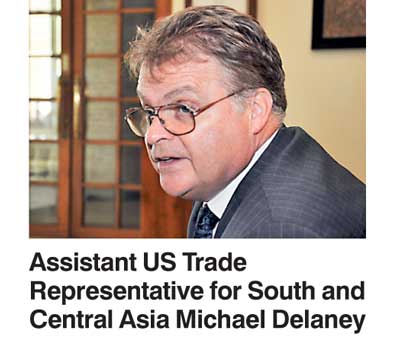Thursday Jan 02, 2025
Thursday Jan 02, 2025
Friday, 30 September 2016 00:54 - - {{hitsCtrl.values.hits}}
 By Uditha Jayasinghe
By Uditha Jayasinghe
The US-Sri Lanka Trade and Investment Framework (TIFA) aims to roll out its first year work plan in the next few weeks and kick off a series of private sector interactions between the two countries, a top official said yesterday, but acknowledged preferential trade access as desired by the Sri Lankan Government would be unlikely.
In April during a TIFA Council meeting, a US-Sri Lanka Joint Action Plan to Increase External Trade and Investment was adopted. The Joint Action Plan aims at reaching its goals over a span of five years to improve trade between the two countries. Currently America is Sri Lanka’s single largest export market accounting for $ 2.9 billion in exports of mostly apparel.
At the April meeting both sides also committed to deepening their engagement to develop a detailed implementation plan for the Action Plan based on specific proposals submitted by Sri Lanka on a range of sectors including improving export competiveness, technical and financial assistance, developing new markets and regional services and promoting greater business interaction and assistance for capacity building of the SME sector.
“The Joint Action plan, which we have more or less finalised, has the aim of removing impediments to greater external trade and investment. What we really need to do and what we are very close to finishing is having a one-year work plan for this five-year plan.
We expect to unveil that in the next few weeks and this will guide us in our work going forward,” Assistant US Trade Representative for South and Central Asia Michael Delaney told the Daily FT.
“We are using several US programming agencies to provide expert assistance to various trade invest-related ministries within the Government of Sri Lanka to increase their knowledge of world-class investment standards and transition to world-class investment standards,” he added.
In addition the two Governments will also organise business-to-business meetings between private sector representatives of the US and Sri Lanka in spring 2017 for what is billed as the first in a series of “business opportunities conferences”. Date, venue and other details are expected to be finalised over the next few weeks, Delaney noted.
The scope of TIFA remains largely structural and limited to public sector interactions between different departments of Washington and Colombo. During TIFA meetings earlier this month International Trade and Development Strategies Minister Malik Samarawickrama proposed that the two Governments work out a preferential trade agreement to achieve faster exports and investment on the ground and warned that the Sri Lankan public was becoming “impatient” for economic returns.
“In the short term we see real challenges to that, mainly because of our election cycle. Our current administration is heading out the door. It will be several months before a new one is stood up and who knows what their policies will be? So in the short term we see this as a challenge,” Delaney admitted advocating instead stronger outreach programs to create awareness among importers and exporters of the existing Generalised System of Preferences (GSP) tariffs Sri Lanka has access to.
However, many of the items included in the 3,500 GSP list are either not manufactured by Sri Lanka or not in large quantities. Apparel, which currently makes up the main export to the US, is largely not included in the GSP program, creating a challenge to boosting exports significantly in the short term.
“A lot of apparel items are not included in GSP,” accepted Delaney, adding that developing a preferential tariff system for apparel would be an uphill task.
“Legally yes it is possible but politically there are real challenges to that.”